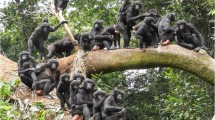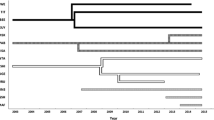Abstract
We investigated patterns of intergroup relationships in western black-and-white colobus, Colobus polykomos, in Taï National Park, Côte d'Ivoire, between 1993 and 1999. They live in one-male multifemale units, and demonstrate male dispersal and occasional dispersal by females. Solitary males and all-male bands are absent or very rare. Our aim was to investigate the function of female and male aggression during intergroup interactions. The species is particularly interesting because, in contrast to predictions from socioecological models, female aggression occurs during intergroup interactions in combination with female dispersal. Home ranges of neighboring groups overlapped considerably and groups lacked an area of exclusive access. Intergroup interactions occurred once every 6.6 observation days. Encounters were either peaceful (12%), or involved displays and threats (25%) or chases and fights (63%). Females interacted in 74% and males in 98% of aggressive intergroup encounters. We found little to no indication that male and female aggression correlated with the presence of food, importance of a location, or presence of infants or receptive females. However, females were more often aggressive during the months when the group depended strongly on seeds from Pentaclethra macrophylla. We also observed forays by males to other groups. Forays occurred on average once every 20 observation days. In 75% of the forays, the intruding male chased members of the target group. In 25% of the forays 1–3 females joined their male but females never attacked the target group. Our main study group was the target of such forays significantly more often when young infants were present in the group than when not. We conclude that female aggression between groups was related to food procurement and that male forays might be related to infanticide.
Similar content being viewed by others
References
Alexander, R. D. (1974). The evolution of social behavior. Annu. Rev. Ecol. Syst. 5: 325–383.
Boesch, C., and Boesch-Achermann, H. (2000). The Chimpanzees of the Taï Forest: Behavioural Ecology and Evolution, Oxford University Press, Oxford, 316 pp.
Borries, C. (1993). Ecology of female social relationships: hanuman langurs (Presbytis Entellus) and the van Schaik model. Folia Primatol. 61: 21–30.
Chapman, C. A., Wrangham, R. W., and Chapman, L. J. (1995). Ecological constraints on group size: an analysis of spider monkey and chimpanzee subgroups. Behav. Ecol. Sociobiol. 36: 59–70.
Cheney, D. L. (1987). Interactions and relationships between groups. In Smuts, B. B., Cheney, D. L., Seyfarth, R. M., Wrangham, R. W., and Struhsaker, T. T. (eds.), Primate Societies, The University of Chicago Press, Chicago, pp. 267–281.
Dasilva, G. L. (1989). The Ecology of the Western Black and White Colobus (Colobus polykomos polykomos Zimmerman 1780) on a Riverine Island in Southeastern Sierra Leone [PhD], University of Oxford, Oxford, England.
Dasilva, G. L. (1992). The western black and white colobus as a low energy strategist: activity budgets, energy expenditure and energy intake. J. Anim. Ecol. 61: 79–91.
Dasilva, G. L. (1994). Diet of Colobus polykomos on Tiwai Island—selection of food in relation to its seasonal abundance and nutritional quality. Int. J. Primatol. 15: 655–680.
Digby, L. J. (1999). Sexual behaviour and extragroup copulations in a wild population of common marmosets (Callithrix jacchus). Folia Primatol. 70: 136–145.
Emlen, S. T., and Oring, L. W. (1977). Ecology, sexual selection, and the evolution of mating systems. Science 197: 215–223.
Fashing, P. J. (2001). Male and female strategies during intergroup encounters in guerezas (Colobus guereza): evidence for resource defense mediated through males and a comparison with other primates. Behav. Ecol. Sociobiol. 50: 219–230.
Fleury, M.-C., and Gautier-Hion, A. (1999). Seminomadic ranging in a population of black colobus (Colobus satanas) in Gabon and its ecological correlates. Int. J. Primatol. 20: 491–509.
Galat, G., and Galat-Luong, A. (1985). La communauté de primates diurnes de la forêt de Taï, Côte d'Ivoire. Rev. Ecol. (Terre Vie) 40: 3–32.
Glander, K. E. (1992). Dispersal patterns in Costa Rican mantled howling monkeys. Int. J. Primatol. 13: 4415–4436.
Harcourt, A. H., Stewart, K. S., and Fossey, D. (1976). Male emigration and female transfer in wild mountain gorilla. Nature 263: 226–227.
Harris, T. R., and Monfort, S. L. (2003). Behavioral and endocrine dynamics associated with infanticide in a black and white Colobus monkey (Colobus guereza). Am. J. Primatol. 61: 135–142.
Harvey, P. H., Martin, R. D., and Clutton-Brock, T. H. (1987). Life histories in comparative perspective. In Smuts, B. B., Cheney, D. L., Seyfarth, R. M., Wrangham, R. W., and Struhsaker, T. T. (eds.), Primate Societies, The University of Chicago Press, Chicago, pp. 181–196.
Hochberg, Y. (1988). A sharper Bonferroni procedure for multiple tests of significance. Biometrika 75: 800–802.
Isbell, L. A. (1991). Contest and scramble competition: patterns of female aggression and ranging behaviour among primates. Behav. Ecol. 2: 143–155.
Isbell, L. A. (2004). Is there no place like home? Ecological bases of female disperseal and philopatry and their consequences for the formation of kin groups. In Chapais, B., and Berman, C. M. (eds.), Kinship and Behaviour in Primates, Oxford University Press, Oxford, pp. 71–109.
Isbell, L. A., and van Vuren, D. (1996). Differential costs of locational and social dispersal and their consequences for female group living primates. Behaviour 133: 1–36.
Isbell, L. A., and Young, T. P. (2002). Ecological models of female social relationships in primates: similarities, disparities, and some directions for future clarity. Behaviour 139: 177–202.
Koenig, A. (2000). Competitive regimes in forest-dwelling Hanuman langur females (Semnopithecus entellus). Behav. Ecol. Sociobiol. 48: 93–109.
Koenig, A. (2002). Competition for resources and its behavioral consequences among female primates. Int. J. Primatol. 23: 759–783.
Koenig, A., and Borries, C. (2001). Socioecology of Hanuman langurs: the story of their success. Evol. Anthropol. 10: 122–137.
Korstjens, A. H. (2001). The Mob, the Secret Sorority, and the Phantoms. An analysis of the Socio-ecological Strategies of the Three Colobines of Taï [PhD], Utrecht University, Utrecht, 174 pp.
Korstjens, A. H., and Noë, R. (2004). The mating system of an exceptional primate, the olive colobus (Procolobus verus). Am. J. Primatol. 62: 261–273.
Korstjens, A. H., Bergman, K., Deffernez, C., Krebs, M., Nijssen, E. C., van Oirschot, B. M. A., Paukert, C., and Schippers, E. P. (in press). How small-scale differences in food competition lead to different social systems in three closely related sympatric colobines. In McGraw, S., Zuberbühler, K., and Noë, R. (eds.), The monkeys of the Taï Forest, Ivory Coast an African Primate Community, Cambridge University Press, Cambridge, UK.
Korstjens, A. H., Sterck, E. H. M., and Noë, R. (2002). How adaptive or phylogenetically inert is primate social behaviour? A test with two sympatric colobines. Behaviour 139: 203–225.
Marler, P. (1969). Colobus guereza: territoriality and group composition. Science 163: 93–95.
Marler, P. (1972). Vocalizations of East African monkeys, II: Black and white colobus. Behaviour 42: 175–197.
Marsh, C. W. (1979). Female transference and mate choice among Tana River red colobus. Nature 281: 568–569.
Martin, P., and Bateson, P. (1993). Measuring Behaviour: An Introductory Guide, Cambridge University Press, Cambridge, UK, 222 pp.
McGraw, W. S. (1996). Cercopithecid locomotion, support use and support availability in the Tai Forest, Ivory Coast. Am. J. Phys. Anthropol. 100: 507–522.
Oates, J. F. (1977). The social life of a black-and-white colobus monkey, Colobus guereza. Z. Tierpsychol. 45: 1–60.
Oates, J. F. (1994). The natural history of African colobines. In Davies, A. G., and Oates, J. F. (eds.), Colobine Monkeys, Cambridge University Press, Cambridge, UK, pp. 75–128.
Oates, J. F., Whitesides, G. H., Davies, A. G., Waterman, P. G., Green, S. M., Dasilva, G. L., and Mole, S. (1990). Determinants of variation in tropical forest primate biomass: new evidence from West Africa. Ecology 71: 328–343.
Onderdonk, D. A. (2000). Infanticide of a newborn black-and-white colobus monkey (Colobus guereza) in Kibale National Park, Uganda. Primates 41: 209–212.
Pope, T. R. (2000). Reproductive success increases with degree of kinship in cooperative coalitions of female red howler monkeys (Alouatta seniculus). Behav. Ecol. Sociobiol. 48: 253–267.
Reichard, U. (1995). Extra-pair copulations in a monogamous gibbon (Hylobates lar). Ethology 100: 99–112.
Sicotte, P., and MacIntosh, A. J. (2004). Inter-group encounters and male incursions in Colobus vellerosus in Central Ghana. Behaviour 141: 533–553.
Siegel, S., and Castellan, N. J. J. (1988). Nonparametric Statistics for the Behavioral Sciences, McGraw-Hill, New York, 399 pp.
Smuts, B. B., and Smuts, R. W. (1993). Male aggression and sexual coercion of females in nonhuman primates and other mammals: evidence and theoretical implications. Adv. Stud. Behav. 22: 1–63.
Stanford, C. B. (1991). Social dynamics of intergroup encounters in the capped langur (Presbytis pileata). Am. J. Primatol.: 35–47.
Starin, E. D. (1991). Socioecology of the Red Colobus Monkey in The Gambia with Particular Reference to Female-Male Differences and Transfer Patterns [PhD], City University of New York, New York, 406 pp.
Starin, E. D. (1994). Philopatry and affiliation among red colobus. Behaviour 130: 253–270.
Steenbeek, R. (1996). What a maleless group can tell us about the constraints on female transfer in Thomas's langurs (Presbytis thomasi). Folia Primatol. 67: 169–181.
Steenbeek, R. (1999). Tenure related changes in wild Thomas's langurs II: Between group interactions. Behaviour 136: 595–650.
Steenbeek, R. (2000). Infanticide by males and female choice in wild Thomas's langurs. In van Schaik, C. P., and Janson, C. H. (eds.), Infanticide by Males and Its Implications, Cambridge University Press, Cambridge, pp. 153–177.
Sterck, E. H. M., and Korstjens, A. H. (2000). Female dispersal and infanticide avoidance in primates. In van Schaik, C. P., and Janson, C. H. (eds.), Infanticide by Males and Its Implications, Cambridge University Press, Cambridge, UK, pp. 293–321.
Sterck, E. H. M., Watts, D. P., and van Schaik, C. P. (1997). The evolution of female social relationships in nonhuman primates. Behav. Ecol. Sociobiol. 41: 291–309.
Stoorvogel, J. J. (1993). Gross Inputs and outputs of nutrients in undisturbed forest, Taï Area, Côte d'Ivoire, The Tropenbor Foundation, Veenman Drukkers, Wageningen.
Strier, K. B., Mendes, F. D. C., Rímoli, J., and Rímoli, A. O. (1993). Demography and social structure of one group of muriquis (Brachyteles arachnoides). Int. J. Primatol. 14: 513–526.
Struhsaker, T. T. (1975). The Red Colobus Monkey, University of Chicago Press, Chicago.
van Schaik, C. P. (1983). Why are diurnal primates living in groups? Behaviour 87: 120–144.
van Schaik, C. P. (1989). The ecology of social relationships amongst female primates. In Standen, V., and Foley, R. A. (eds.), Comparative Socioecology. The Behavioural ecology of Humans and Other Mammals, Blackwell, Oxford, pp. 195–218.
van Schaik, C. P. (1996). Social evolution in primates: the role of ecological factors and male behaviour. Proc. Brit. Acad. 88: 9–31.
van Schaik, C. P., Assink, P. R., and Salafsky, N. (1992). Territorial behavior in Southeast Asian langurs: resource defense or mate defense. Am. J. Primatol. 26: 233–242.
van Schaik, C. P., and van Hooff, J. A. R. A. M. (1983). On the ultimate causes of primate social systems. Behaviour 85: 120–144.
Watts, D. P. (1989). Infanticide in mountain gorillas: new cases and a reconsideration of the evidence. Ethology 1–18.
Wrangham, R. W. (1980). An ecological model of female bonded primate groups. Behaviour 75: 262–300.
Author information
Authors and Affiliations
Corresponding author
Rights and permissions
About this article
Cite this article
Korstjens, A.H., Nijssen, E.C. & Noë, R. Intergroup Relationships in Western Black-and-White Colobus, Colobus polykomos polykomos . Int J Primatol 26, 1267–1289 (2005). https://doi.org/10.1007/s10764-005-8853-y
Received:
Revised:
Accepted:
Issue Date:
DOI: https://doi.org/10.1007/s10764-005-8853-y




